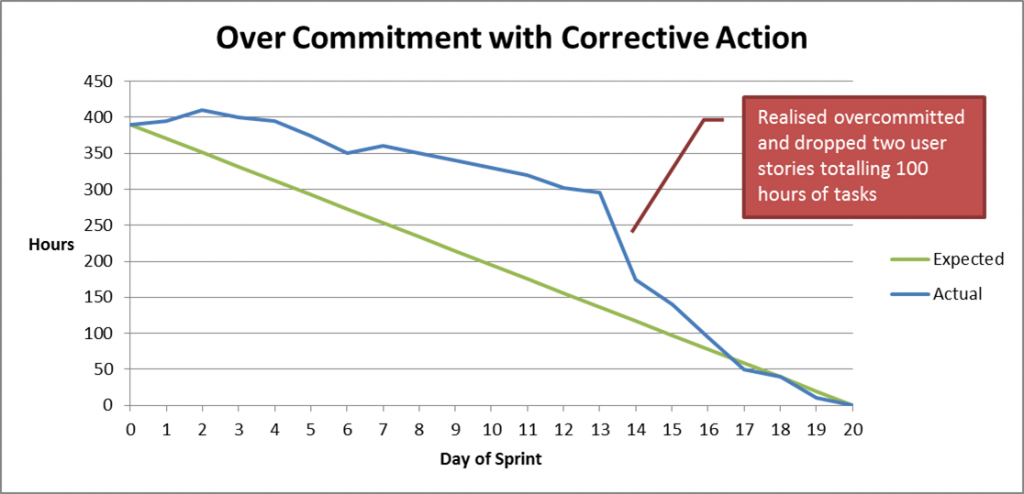The guys at Agility in Mind (AIM) recently ran a retrospective for me. I thought their approach was cute and worth a quick post. They prompted the team for things that made them glad, sad and mad.
Continue reading
Tag Archives: monitoring and control
Reporting Percentage Complete on an Agile Project
What do you do when management asks for a percentage complete on an Agile project? The flippant answer is “tell them the percentage complete”. Agilists reject percentage complete when reporting on low level stuff. But for the project as a whole you can get quite an interesting metric, one that is based on real data, so why not calculate and share it.
90% Complete not = Done
What do you do when a developer claims “I’m 90% complete”? Well, don’t rely on it and patiently wait for 100%.
Continue reading
Daily Plan: Stand up to Plan the Day
“Stand up please”. Old habits die hard and because I started Agile with Extreme Programming I “Stand up”, I don’t “Scrum”. Otherwise the two types of meeting are pretty similar. “What have you done since we last met? What will you do before we meet again? Any impediments?”
Great meeting. Wrong questions.
As Mike Cohn explained back in 2006, and Matt Wynne reminded me last year, the daily meeting is a Planning session. It is part of Mike’s planning onion because the aim of the “Stand up” is to develop the plan for the day.
Continue reading
What do I do When the Project Manager is late for their own daily meeting
I got asked what I do when the Agile Project Manager is late for their own daily meeting?
Continue reading
No walls: What to do when you’ve no Walls for your Informative Workspace
You move into a lovely new office. Lots of light and open spaces. Beautiful. Modern. But no walls.
Agile kind of assumes you’ve got walls. Whiteboards. Sprint Plan. Product Backlog. Burn down Charts. Kanban boards. Cumulative Flow Diagrams. All prominently displayed to transform your office into an Informative Workspace.
So what do you do when there are no walls?
Continue reading
Epics: My Love Hate Relationship with Large User Stories
Epics aren’t very good for driving the development team because Epics lack sufficient detail and will take too long to complete anyway. But Epics are, like their smaller relatives the user story, great as a place holder for a conversation.
Continue reading
The Fallacy of Control within Project and Programme Management
The most liberating day of my career was when I realised that, despite being responsible for the project I was running at the time, I actually controlled very little of what happened. That was the day I freed myself from the “fallacy of control”.
I can’t really control who does what. I can’t really control whether an individual does the work to an acceptable quality. I can’t control whether or not the product owner is going to change their mind about priorities. I can’t control whether the proposed technical solution turns out to be much harder than anticipated or just a dead end.
All I can really do is influence what happens in my programme/project. Spot issues quickly and react appropriately. Lean-Agile gives me the tools to do that.
Continue reading
Correcting Overcommitment during a Sprint
As I’ve said before the most common problem I’ve seen with software development teams is over commitment. If worse comes to worst you get to the end of the spring before realising the problem. But you don’t have to wait until the end of a sprint to take corrective action.
This post was prompted by a comment, by Chris, on the post where I described what to do when tasks in the Sprint Plan are not finished. My assumption in that post was the team only realises they are overcommitted at the end of the sprint. And for first time teams that is often exactly what happens.
What I didn’t mention is that more mature teams are likely to spot what is going on earlier.
Continue reading
What is Agile Governance?
Personally I think good governance is essential for successful delivery, either within a programme or project, or part of on-going product development.
The recent publication of Governance for Agile delivery: Examples from the private sector July 2012 by the British National Audit Office suggests the UK government is also very interested in Agile and how it can be used to deliver value. But within the constraints of good governance.
However the term “governance” is rarely used along side “Agile”. As a agile programme manager I thought I’d try to answer the question “What is Agile Governance?”
Continue reading
